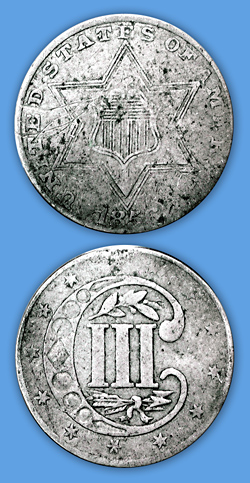|
"Making Cents"
The Signal
Saturday, August 12, 2006
| P |
Designed by James B. Longacre, better known for his Indian head cent design, it was made of .900 fine silver and weighed only three-fourths of a gram. By contrast, a modern cent weighs 2.5 grams. The three-cent silver piece was 14 mm in diameter; a cent is 19.1 mm. It also was the first U.S. coin not to portray the head or figure of Miss Liberty. On the obverse was a six-pointed star with a shield in the center with the date below. The reverse design featured the Roman numeral III in the center with a highly ornate "C" surrounding it.
The purpose of the coin was twofold: to meet the shortage of small change in the expanding Westernization of American by mid-century, and to compete with small foreign silver coins then in circulation, particularly fractions of the real from Mexico and Latin America.
Since foreign coins officially lost their legal-tender status in 1857, their days in use for general commerce, except in isolated territories, were numbered. Also, by 1851, the population of large cents was so small that only the larger cities ever saw any in general use.
Small change was hard to make; in those days, a penny could buy two loaves of bread, a gallon of milk or a 5-pound bag of salt. A "middle coin" between the cent and half dime was considered necessary for general commercial use.
The choice of silver, however, proved to be the coin's undoing. Since it was so small in diameter and so thin, they were easily lost or bent.
Between 1851 and 1853, more than 35 million pieces were struck and distributed. Between 1854 and 1858, a little more than 2 million were struck. From 1859 to 1864, fewer than 1.5 million pieces were struck in total. Most were hoarded or melted for other uses. Many were lost. They did not gain a foothold in American coinage, and between 1865 and 1873, a mere 56,000 pieces were struck; all are considered scarce to rare in all grades. Most pieces of this period are known in mint grades (uncirculated condition) since they were squirreled away by collectors and speculators.
Since the need for a middle coin between the cent and five-cent nickel was still needed, a new three-cent coin made of copper nickel was issued beginning in 1865, and running through 1889. By the early 1880s, it was evident that the denomination was not favored by merchants; it saw little use outside of big cities. Longacre also designed the copper nickel version.
Today, almost any three-cent silver coin (also known as a "trime") is a collector item. Except for the four or five common dates, almost all others are highly prized by collectors. Mint specimens from 1865 to 1873 run into the thousands of dollars each. Many surviving pieces have been made into coin jewelry (as "love tokens") or mounted as charms on bracelets and necklaces.
For as little as $20, one may find a well-used specimen of this denomination in a coin shop — but only of one of the common dates. For kids, it would make a great "show and tell" item in school.
Dr. Sol Taylor of Sherman Oaks is president of the Society of Lincoln Cent Collectors and author of The Standard Guide to the Lincoln Cent. Click here for ordering information.
©2006, THE SIGNAL · ALL RIGHTS RESERVED.

![[Most Recent Quotes from www.kitco.com]](http://www.kitconet.com/images/quotes_special.gif)

